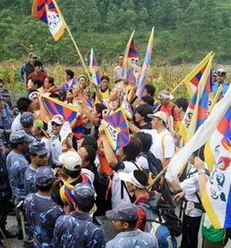Note: This novel was WINNER of the Man Booker Prize in 2006.
“Caught up in the mythic battles of past and present, justice and injustice.”
Writing with wit and perception, Kiran Desai creates an elegant and thoughtful study of families, the losses each member must confront alone, and the lies each tells to make memories of the past more palatable. Sai Mistry is a young girl whose education at an Indian convent school comes to an end in the mid-1980s, when she is orphaned and sent to live with her grandfather, a judge who does not want her and who offers no solace. Living in a large, decaying house, her grandfather considers himself more British than Indian, far superior to hard-working but poverty-stricken people like his cook, Nandu, whose hopes for a better life for his son are the driving force in his life.
perception, Kiran Desai creates an elegant and thoughtful study of families, the losses each member must confront alone, and the lies each tells to make memories of the past more palatable. Sai Mistry is a young girl whose education at an Indian convent school comes to an end in the mid-1980s, when she is orphaned and sent to live with her grandfather, a judge who does not want her and who offers no solace. Living in a large, decaying house, her grandfather considers himself more British than Indian, far superior to hard-working but poverty-stricken people like his cook, Nandu, whose hopes for a better life for his son are the driving force in his life.
The story of Sai, living in Kalimpong, near India’s northeast border with Nepal, alternates with that of Biju, Nandu’s son, an illegal immigrant trying to find work and a better life in N ew York. Biju, working in a series of deadend jobs, epitomizes the plight of the illegal immigrant who has no future in his own country and who endures deplorable conditions and semi-servitude working illegally in the US. As Desai explores the aspirations of Sai and Biju, the hopes and expectations of their families, and their disconnections with their roots, she also creates vivid pictures of the friends and relatives who surround them, evoking vibrant images of a broad cross-section of society and revealing the social and political history of India.
ew York. Biju, working in a series of deadend jobs, epitomizes the plight of the illegal immigrant who has no future in his own country and who endures deplorable conditions and semi-servitude working illegally in the US. As Desai explores the aspirations of Sai and Biju, the hopes and expectations of their families, and their disconnections with their roots, she also creates vivid pictures of the friends and relatives who surround them, evoking vibrant images of a broad cross-section of society and revealing the social and political history of India.
Though Sai’s romance, at sixteen, with Gyan, her tutor, provides her with an emotional escape from Kalimpong, it soon becomes complicated by Gyan’s involvement with the Gorkha National Liberation Federation, a Nepalese independence movement which quickly becomes violent. Gyan’s commitment to the insurgency offers an ironic contrast with the commitment of his family to the colonial British army in earlier times, just as the judge’s hatreds, learned in England, are ironically contrasted with his British affectations in later life.
A careful observer of be havior, with a fine eye for revealing details, Desai brings her narrative and characters to life, illustrating her themes without making moral judgments about her characters–creating neither saints nor villains, just ordinary people leading the best lives they can, using whatever resources are available. Her characters, like people from all cultures, make sacrifices for their children, behave cruelly toward people they love, reject traditional ways of life and old values, rediscover what is important to them, suffer at the hands of faceless government officials, and learn, and grow, and make decisions, sometimes ill-considered, about their lives. Dealing with all levels of society and many different cultures, Desai shows life’s humor and brutality, its whimsy and harshness, and its delicate emotions and passionate commitments in a novel that is both beautiful and wise. (On my Favorites list for 2006)
havior, with a fine eye for revealing details, Desai brings her narrative and characters to life, illustrating her themes without making moral judgments about her characters–creating neither saints nor villains, just ordinary people leading the best lives they can, using whatever resources are available. Her characters, like people from all cultures, make sacrifices for their children, behave cruelly toward people they love, reject traditional ways of life and old values, rediscover what is important to them, suffer at the hands of faceless government officials, and learn, and grow, and make decisions, sometimes ill-considered, about their lives. Dealing with all levels of society and many different cultures, Desai shows life’s humor and brutality, its whimsy and harshness, and its delicate emotions and passionate commitments in a novel that is both beautiful and wise. (On my Favorites list for 2006)
Notes: The author’s photo is from http://www.telegraphindia.com
The photo of Kalimpong, where Sai’s grandfather lives, is from http://www.vacationsindia.com
Students (like Gyan) confront police from Nepal as they try to stage a protest march as part of their “Free Tibet” campaign in June, 2009. http://atibetan.blogspot.com
